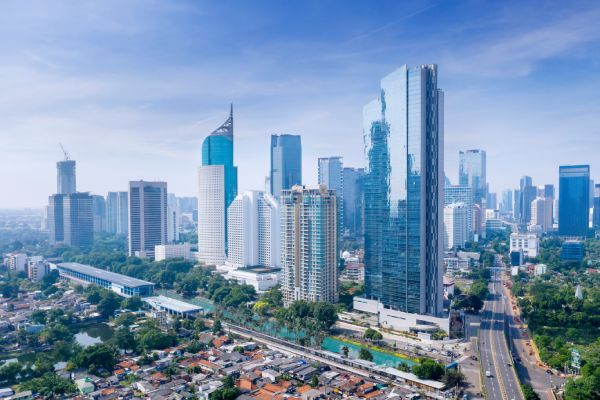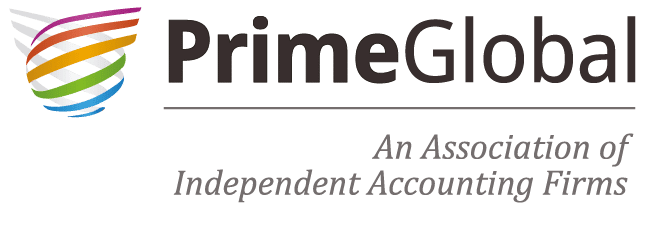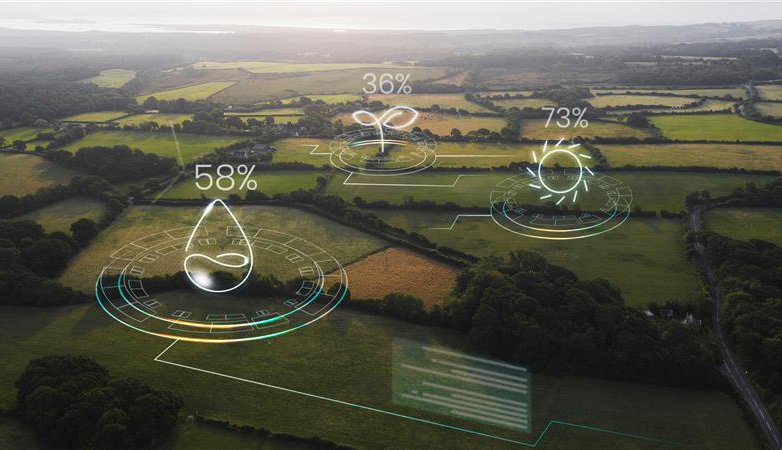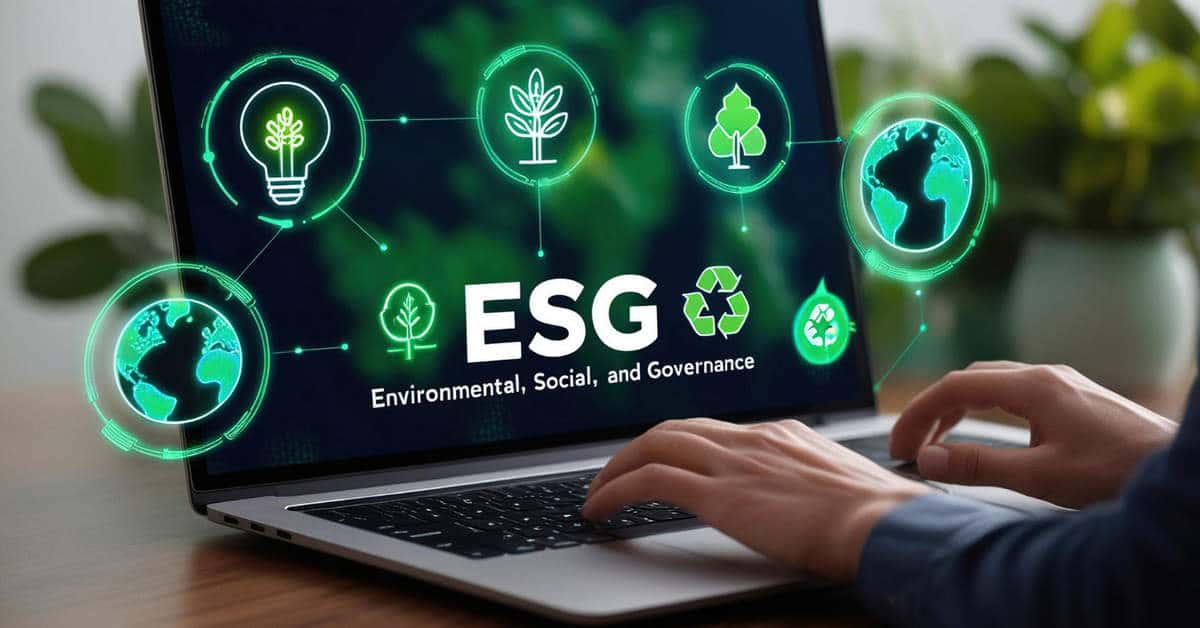The Rise of BRSR Reporting in India: Key Challenges, Implications and Strategies for Businesses

The Rise of BRSR Reporting in India: Key Challenges, Implications and Strategies for Businesses
BRSR Reporting in India: Key Challenges and Business Implications in the Sustainability Reporting Framework
- Authors
- Last Updated
- Tags
- Last Updated
- Authors
- Last Updated
- Tags
ESG reporting originated in India as a part of CSR guidelines introduced into India in 2009 and has seen a rapid momentum since then. In the last decade, thousands of organizations around the globe have developed and implemented various forms of ESG reporting frameworks. International agencies such as the EU, GRI, and the TCFD lead the designing of these frameworks. But India has one more specifically prepared framework of its own, the one initiated by SEBI – known as Business Responsibility and Sustainability Reporting. BRSR is successor to another big reporting framework, the Business Responsibility Report that SEBI inducted in the year 2012.
Given the complexity of such reporting frameworks, businesses are bound to face a myriad of challenges in adopting them. This blog explores some of the key challenges and implications for businesses adopting the BRSR reporting framework.
Overview of BRSR Reporting
BRSR is the primary reporting framework for Indian public companies. It caters to the requirement of having a standardized framework for sustainability reporting and makes the top 1000 listed companies by market capitalization disclose their ESG performance data through a compiled report. BRSR outlines the parameters that need to be reported and guides the way these need to be reported. Transparency is to be fostered by the overall idea of the BRSR. There are three major components of the BRSR, which are outlined below.
Section A: General Disclosures
This section contains the basic information regarding the company that includes products and services, strength of employees, location, roadmap, etc. In other words, this section of the report would introduce the company to the readers.
Section B: Management and Process Disclosures
In this chapter, the business entity discloses the processes and policies followed by the management with regard to National Guidelines on Responsible Business Conduct. These are further described below, which will allow an understanding if the business possesses the necessary pre-requisites so that responsible practices can be observed.
Section C: Principle-wise Performance Disclosures
This section discusses the results and performance of the relevant entity for each of the nine principles of NGRBC. Below two measures for every principle should be reported on by the entities.
- Essential Indicators (Mandatory)
The results and performance of the relevant entity for each of the nine principles of NGRBC are discussed in this section. It includes elements like community initiatives, training sessions, and social impact.
- Leadership Indicators (Voluntary)
These indicators include voluntary disclosures. Companies are expected to report on these indicators as good practice as they provide insight into the vision set by the leadership. Parameters like Scope 3 emissions, board diversity, risk management, and health & safety assessment of value chain partners are included in these indicators.
BRSR reporting is line with the nine core principles of the NGRBC, a set of guidelines put forth by the Ministry of Corporate Affairs (MCA) in March 2019 to promote responsible business conduct in the Indian corporate environment.
Following are the nine focus areas of NGRBC
- Ethical Business Practices
- Product Stewardship
- Employee Wellbeing and Engagement
- Stakeholder Engagement
- Human Rights
- Environmental Stewardship
- Public Policy Advocacy
- Inclusive and Equitable Growth
- Customer Focus
Furthermore, the homogeneity of data across all sustainability disclosers is promoted by the BRSR reporting framework, which is designed to align with internationally acclaimed reporting standards like UN SDG’s. This comparability is set to support more responsible investor decisions because ultimately, the said reports are put into use by platforms like the rating agencies under the ESG umbrella.
Evolution of BRSR Reporting
BRSR reporting is the more elaborate successor of BRR reporting – BRR evolved into BRSR in the year 2021 as the move was directed by SEBI.

Related Read: How to Choose Right ESG Reporting Framework for Business
Timeline of events
2009 – Voluntary Guidelines on Corporate Social Responsibility were published by the Ministry of Corporate Affairs (MCA).
2011 – National Voluntary Guidelines (NVGs) on Social, Environmental and Economic Responsibilities of Business 2011: MCA Issued
2012 – SEBI mandated reporting on BRR for the top 100 companies by market capitalization.
2016 – Top 500 companies by market capitalization were given a mandate to file BRRs.
2017 – The suggestion to voluntarily adopt Integrated Reporting from FY 2017-18 by the top 500 companies by market capitalization was made by SEBI.
2019 – NGRBCs were updated to NVRGs, and BRR was expanded to the top 1000 companies by market capitalization by SEBI.
2021 – SEBI introduced BRSR to the top 1000 listed entities by market capitalization.
2023 – New parameters were added to BRSR, and BRSR core parameters for reasonable assurance under a glide path were introduced, starting with the top 150 listed entities from FY 2023-24.
Evolution of BRR into BRSR
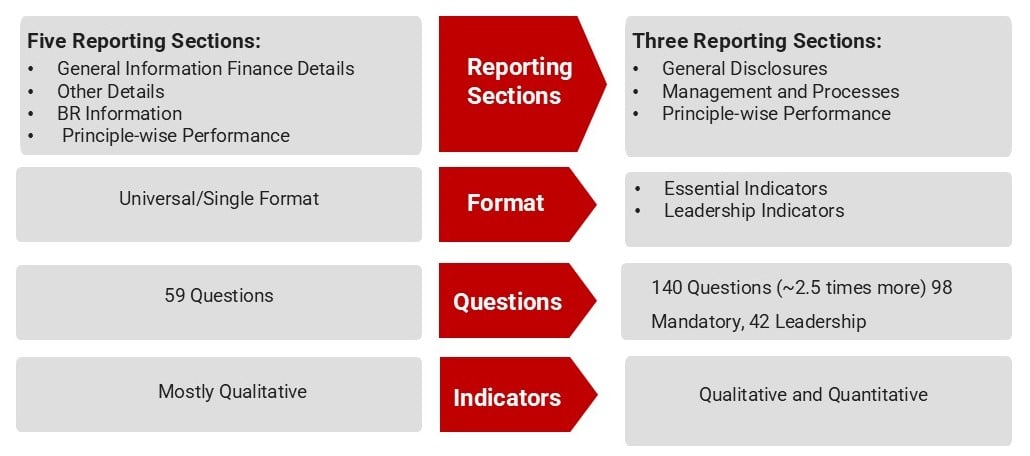
How should businesses prepare to report under BRSR?
As per circular SEBI/HO/CFD/CFD-SEC-2/P/CIR/2023/122, SEBI has mandated the top 1000 listed entities by market capitalization to prepare BRSR as per the updated format.
Mentioned below are some best practices when carrying out reporting under BRSR:
- Engagement surveys with existing stakeholders should be conducted by organizations to understand the overall expectations of the stakeholders. For instance, if an organization understands how customers think about community service, then it will be able to align itself with the requirements of customers.
- BRSR has both mandatory and voluntary questions, it is always better for organizations to answer both because it can instill more confidence in investors over the long-term vision of the leadership.
- Scope 3 emissions like third-party energy consumption, greenhouse gas emissions, water intake, and waste disposal can be disclosed by entities as part of the voluntary set of questions. It is shown that overall environmental impacts across its supply chain are being reduced by an organization.
Implications for Corporate Governance
Corporate governance relates to the rules, regulations, and policies set by a firm on its corporate conduct. The first principle of NGRBC entails responsible and ethical practices that provide a positive influence on communities and the environment. This is pivotal in creating confidence for investors, clients, public officials, and consumers. It explicitly reveals the business values and the direction of any company right from the onset, making it pertinent to the transparent behavior of any firm.
Negative corporate governance might lead to public flak and in some cases, bankruptcy. BRSR following the principles of NGRBC emphasizes good corporate governance and highlights many of the essential indicators requiring companies to disclose information about their practice.
Investor Perspectives: Benefits of BRSR Reporting
Informed Decisions
The holistic nature of the BRSR framework forces companies to provide disclosures of ESG-related metrics in response to 140 questions. The disclosed information would assist investors to make the correct decisions. Such decisions are more likely to involve high returns to stakeholders, because they express a long-term view of the vision of the company.
Transparency

Related Read: The Ultimate Guide to EcoVadis Certification
An organization is made more transparent in the opportunities and challenges that it faces by the BRSR report. To fill in the BRSR report, there is a need to disclose the information throughout the operations of the company, thereby assisting investors to responsibly manage their investments.
Innovation
“It was rightly said by Dirk Visser, Senior Lecturer at Monash Sustainable Development Institute, that ‘Ambitiousness in ESG strategy is what is going to unlock value and innovation’. Mitigating risks and achieving ESG requirements according to frameworks like BRSR are often seen to push an entity towards innovation. Mechanisms are developed to cut down traditional, outdated practices and introduce new measures to mitigate future risks.”
Increased Returns
Sustainable avenues for investment can ensure maximum returns to investors, the Durham Magazine said in a recent study. Everyone knows that companies which make sustainability as part of their core values are better positioned to outperform the competition in the long run. Therefore, BRSR reporting is financially beneficial for all stakeholders.
Efficiency
The operational efficiency of an organization is increased by profiling ESG risks and their mitigating policies. This increase in operational efficiency can be shared by investors and other stakeholders without having a significant surprise setback.
Challenges and Barriers to Implementation
BRSR reporting is an ever-evolving phenomenon, much ambiguity is found around the reporting framework. Few challenges and barriers to the implementation of BRSR reports are highlighted in the table below.
| Challenge | Description |
|---|---|
| Changes in Reporting Requirements | Frequent updates in regulations can create confusion |
| Inadequate ESG Awareness | Lack of understanding among employees and management about ESG principles |
| Outdated Data Collection Pipelines | Existing systems may not efficiently capture relevant sustainability data |
| Increased Internal Dependency | Reliance on multiple departments can lead to delays and miscommunication |
| High Short-term Costs | Initial investments in systems and training may discourage businesses from adopting BRSR |
| Ambiguous Wording and Implementation | Unclear guidelines can lead to inconsistent reporting and misinterpretation |
| Limited Internal Tools and Resources | Insufficient technology and support can hinder effective data management |
| Verification of Information | Ensuring the accuracy and credibility of reported data may require third-party audits |
| Complex Reporting Requirements | Organizations struggle with the complexity of the BRSR framework |
Strategies for Successful BRSR Implementation
The steps required to formulate a report according to the framework are formulated by BRSR. The ease of reporting ESG metrics of organizations is aided by designed process flow. The strategy for successful implementation of BRSR reporting should include:
- A thorough understanding of the BRSR Framework
- An ESG charter should be formalized
- Standard Operating Procedures (SOPs) for Data collection and Reporting
- The Supply Chain should be assessed
- Stakeholders are engaged
- A Materiality Assessment is conducted
- Key Performance Indicators (KPIs) are established and Process Measures are implemented
- Ongoing Training is provided to Internal Teams involved in BRSR data collection and reporting
- All Required KPIs are gathered
- Data Consolidation and Validation are done
- Pre-assurance Checks are conducted
- Third-Party External Assurance Providers are engaged (if required)
InCorp Comprehensive Approach to BRSR Reporting
At InCorp, organizations are assisted to move with the intricacies of BRSR. Extensive work has been done on formalizing a robust ESG charter for clients, against the industry standard and driving regulatory requirements. This way, clients are helped with developing standard operating procedures for proper execution with collection and reporting of data. Capabilities range from supply chain assessment through interaction with key stakeholders to materiality assessments in defining priority sustainability issues. The definition of Key Performance Indicators (KPI), process measures, and training of internal teams for data collection and reporting on BRSR are supported to be smoother. Gathering, consolidation, and validation of any pre-assurance checks to ensure greater accuracy are also assisted by us.
Future Outlook for BRSR Reporting in India
BRSR is being used to anchor the ESG reporting environment in India – it is considered the leading regulatory framework in the country. A unified framework aimed to ease the process and increase transparency of reporting ESG metrics for your organization is intended to be provided by BRSR. One of the most efficient ways of navigating the BRSR in the future will be for ESG to be incorporated into core business strategy by aligning company objectives with sustainability criteria. Other changes must also be overseen regarding regulatory changes in ESG reporting. Organizations must monitor the current trends as well as the future ones.
The International Organization of Securities Commission also recommended the need to have a framework for ESG reporting that was consistent and had a quantitative outcome in its work plan on sustainable finance. The step is vital in standardizing the reporting process and developing a consistency in reporting standards. Being a part of the ever-widening reach of the regulatory panorama around sustainability, there is an evident indication that global ESG frameworks will develop into a more holistic and interlinked mechanism. The BRSR too would mature to change as the other global frameworks evolve in its wake to remain relevant.
Conclusion
BRSR is championing ESG reporting in India. It has developed the marquee framework for the propagation of ESG reporting process across the country. BRSR has been brought international popular sustainability reporting mechanisms with a more holistic outlook and more relevant questions towards the ESG requirements. Steady growth has been seen in sustainable investments in the last decade and is expected to take off in the near future. Additionally, with more SEBI regulatory requirements, further growth in sustainable investments is expected.
As mentioned above in this article, the BRSR also brings with it a set of challenges that must be addressed. In other words, some of the difficulties faced by organizations include having to keep pace with changing reporting requirements and maintaining accurate data acquisition pipelines. These problems can be mitigated by reaching out to ESG professionals with appropriate experience.
Why Choose InCorp Global?
A team of dedicated professionals with expertise in BRSR reporting is maintained by InCorp Global. Apart from BRSR, solutions on multiple frameworks like the GRI, TCFD, IFRS, EcoVadis, MSCI, S&P, EU CSRD, GRESB, and more are provided by us. A diverse range of clientele spanning across various industries is served by InCorp. We provide point-to-point solutions, from the assessment of ESG parameters to the reporting of sustainability disclosures. To contact InCorp Global, an email can be written to us at info@incorpadvisory.in or contact can be made at (+91) 77380 66622.
Authored by:
Muskaan Jain | Sustainability & ESG
FAQs
- If the listed Company is in the top one thousand market capitalization list on any Exchange, then filing BRSR is required by the listed Company with both the Exchanges.
- The cross-reference of the disclosures sought under the BRSR can be provided by those listed Companies which prepare and disclose sustainability reports (as part of annual report) based on internationally accepted reporting frameworks such as GRI, SASB, TCFD, Integrated Reporting. Furthermore, if the data sought in the reporting format is already disclosed in the annual report, a cross-reference to the same can be provided by the listed Company.
The same information need not be disclosed twice in the annual report by a Company. However, the page number of the annual report or sustainability report where the information sought under the BRSR format is disclosed as part of the report prepared based on internationally accepted reporting framework should be specifically mentioned by the Company.
- As of 31 March 2024, an annual BRSR sustainability report must be prepared by the top 1000 listed entities by market capitalization. The following is the list of the largest companies by market capitalization.
https://www.nseindia.com/regulations/listing-compliance/nse-market-capitalisation-all-companies
- The BRSR is to be mandatorily submitted with the Exchange in PDF and XBRL. The path for submitting the same is explained briefly below.
XBRL & PDF: Path: NEAPS > Common XBRL Upload > Business Responsibility & Sustainability Report.
Share
Share














